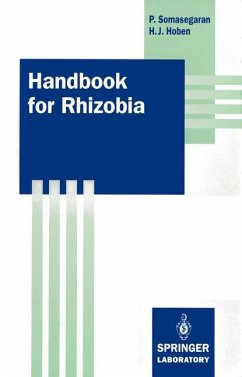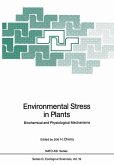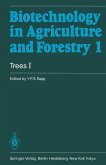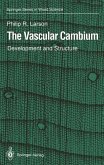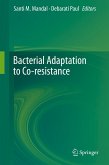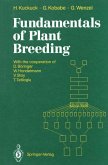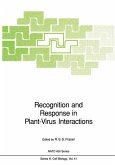- Broschiertes Buch
- Merkliste
- Auf die Merkliste
- Bewerten Bewerten
- Teilen
- Produkt teilen
- Produkterinnerung
- Produkterinnerung
Rhizobia are bacteria which inhabit the roots of plants in the pea family and "fix" atmospheric nitrogen for plant growth. They are thus of enormous economic importance internationally and the subject of intense research interest. Handbook for Rhizobia is a monumental book of practical methods for working with these bacteria and their plant hosts. Topics include the general microbiological properties of rhizobia and their identification, their potential as symbionts, methods for inoculating rhizobia onto plants, and molecular genetics methods for Rhizobium in the laboratory. The book will be…mehr
Andere Kunden interessierten sich auch für
![Environmental Stress in Plants Environmental Stress in Plants]() Environmental Stress in Plants115,99 €
Environmental Stress in Plants115,99 €![Trees I Trees I]() Y. P. S. BajajTrees I77,99 €
Y. P. S. BajajTrees I77,99 €![The Vascular Cambium The Vascular Cambium]() Philip R. LarsonThe Vascular Cambium120,99 €
Philip R. LarsonThe Vascular Cambium120,99 €![Molecular Strategies of Pathogens and Host Plants Molecular Strategies of Pathogens and Host Plants]() Molecular Strategies of Pathogens and Host Plants38,99 €
Molecular Strategies of Pathogens and Host Plants38,99 €![Bacterial Adaptation to Co-resistance Bacterial Adaptation to Co-resistance]() Bacterial Adaptation to Co-resistance112,99 €
Bacterial Adaptation to Co-resistance112,99 €![Fundamentals of Plant Breeding Fundamentals of Plant Breeding]() Hermann KuckuckFundamentals of Plant Breeding90,99 €
Hermann KuckuckFundamentals of Plant Breeding90,99 €![Recognition and Response in Plant-Virus Interactions Recognition and Response in Plant-Virus Interactions]() Recognition and Response in Plant-Virus Interactions77,99 €
Recognition and Response in Plant-Virus Interactions77,99 €-
-
-
Rhizobia are bacteria which inhabit the roots of plants in the pea family and "fix" atmospheric nitrogen for plant growth. They are thus of enormous economic importance internationally and the subject of intense research interest. Handbook for Rhizobia is a monumental book of practical methods for working with these bacteria and their plant hosts. Topics include the general microbiological properties of rhizobia and their identification, their potential as symbionts, methods for inoculating rhizobia onto plants, and molecular genetics methods for Rhizobium in the laboratory. The book will be invaluable to Rhizobium scientists, soil microbiologists, field and laboratory researchers at agricultural research centers, agronomists, and crop scientists.
Produktdetails
- Produktdetails
- Verlag: Springer / Springer New York / Springer, Berlin
- Artikelnr. des Verlages: 978-1-4613-8377-2
- Softcover reprint of the original 1st ed. 1994
- Seitenzahl: 472
- Erscheinungstermin: 17. November 2011
- Englisch
- Abmessung: 254mm x 178mm x 26mm
- Gewicht: 881g
- ISBN-13: 9781461383772
- ISBN-10: 1461383773
- Artikelnr.: 36121597
- Herstellerkennzeichnung
- Springer-Verlag GmbH
- Tiergartenstr. 17
- 69121 Heidelberg
- ProductSafety@springernature.com
- Verlag: Springer / Springer New York / Springer, Berlin
- Artikelnr. des Verlages: 978-1-4613-8377-2
- Softcover reprint of the original 1st ed. 1994
- Seitenzahl: 472
- Erscheinungstermin: 17. November 2011
- Englisch
- Abmessung: 254mm x 178mm x 26mm
- Gewicht: 881g
- ISBN-13: 9781461383772
- ISBN-10: 1461383773
- Artikelnr.: 36121597
- Herstellerkennzeichnung
- Springer-Verlag GmbH
- Tiergartenstr. 17
- 69121 Heidelberg
- ProductSafety@springernature.com
I. General Microbiology of Rhizobia.- 1. Collecting Nodules and Isolating Rhizobia.- 2. Observing the Infection Process.- 3. Cultural Properties, Cell Morphology, and Nutritional Requirements of Rhizobia.- 4. Demonstrating Genetic Diversity in Rhizobia Using Patterns of Carbohydrate Utilization and Intrinsic Antibiotic Resistance.- 5. Quantifying the Growth of Rhizobia.- 6. Counting Rhizobia by a Plant Infection Method.- 7. Counting Serologically Specific Rhizobia in Soil and Peat Inoculants Using Membrane Filters and Immunofluorescence.- Additional References and Recommended Reading.- II. Identification of Rhizobia.- 8. Developing Antisera.- 9. Somatic Agglutination Reactions with Pure Cultures of Rhizobia.- 10. Agglutinating Antigens from Root Nodules.- 11. Performing Rhizobial Antigen-Antibody Reactions by Gel Immunodiffusion.- 12. Determining Strain Occupancy in Soybean Nodules by Gel Immunodiffusion.- 13. Producing and Applying Fluorescent Antibodies.- 14. Identifying Rhizobia bythe Indirect Enzyme-Linked Immunosorbent Assay.- 15. Identifying Rhizobia by Immunoblot.- 16. Isolating Spontaneous Antibiotic-Resistant Mutants of Rhizobia.- 17. Analyzing Nodule Occupancy Using Antibiotic-Resistant Markers.- 18. Distinguishing between Strains of Rhizobia by Rhizobiophage Susceptibility.- Additional References and Recommended Reading.- III. Evaluating Symbiotic Potential of Rhizobia.- 19. Testing For Genetic Compatibility between Rhizobia and Legumes.- 20. Screening Rhizobia for Nitrogen-Fixation Potential.- 21. Screening Effective Strains of Rhizobia in Potted Field Soil.- 22. Verifying the Nitrogen-Fixing Potential of Glasshouse-Selected Soybean Rhizobia in the Field Environment.- 23. Evaluating the Symbiotic Potential of Indigenous Rhizobial Populations of Soils Using the Whole-Soil Inocula Technique.- 24. Investigating the Importance of Optimal Soil Fertility in the Response of a Legume to Inoculation with Rhizobia.- Additional References and Recommended Reading.-IV. Inoculant Technology.- 25. Producing Broth Cultures in Simple Glass Fermentors.- 26. Producing Inoculum in a Steel Fermentor.- 27. Preparing a Range of Carrier Materials and Producing Inoculants.- 28. Preparing Inoculants Using Diluted Cultures of Rhizobia and Presterilized Peat.- 29. Testing the Survival of Rhizobia on Inoculated Seeds.- Additional References and Recommended Reading.- V. Genetic Techniques for Rhizobia.- 30. Analyzing Plasmid Profiles of Rhizobium spp. by a Modified Eckhardt Vertical Gel Electrophoresis Procedure.- 31. Isolating and Purifying Genomic DNA of Rhizobia Using a Large-Scale Method.- 32. Isolating and Purifying Genomic DNA of Rhizobia Using a Rapid Small-Scale Method.- 33. Digesting Genomic DNA of Rhizobia with Restriction Endonucleases.- 34. Separating Restriction Fragments of Genomic DNA by Horizontal Agarose Gel Electrophoresis.- 35. Transferring Electrophoretically Separated DNA from Agarose Gels to a Membrane by Southern Blotting.- 36. Preparing aDNA Probe for Detecting the nif Genes on Symbiotic Plasmids of Rhizobium spp.- 37. Incorporating a Nonradioactive Label into a DNA Probe by Nick Translation.- 38. Using a Nonradioactively Labeled nifKDH Gene Probe to Locate Complementary Sequences of Rhizobial DNA Immobilized on Membranes.- Additional References and Recommended Reading.- VI. Appendices.- 1. Characteristics of the Subfamilies of Legumes.- 2. The Nodule Preservation Vial.- 3. Bacterial Growth Media and Plant Nutrient Solutions.- 4. Reagents and Buffers.- 5. Molecular Biology Reagents and Buffers.- 6. McFarland Nephelometer Barium-Sulfate Standards.- 7. Preparing Seedling-Agar Slants and NifTAL-Tubes for Culturing Small-Seeded Legumes.- 8. Building a Rack for Growth Pouches.- 9. Recommendations of Legumes and Growth Systems for Authentication.- 10. Seed Surface Sterilization and Germination.- 11. Preparing Leonard Jars.- 12. Injecting and Bleeding Rabbits.- 13. The Indirect Fluorescent Antibody Technique.- 14. AdditionalInformation on the Plant Infection Count.- 15. The Acetylene Reduction Assay for Measuring Nitrogenase Activity.- 16. Methods for Determining Lime Requirements of Acid Soils.- 17. Analysis of Variance for a Rhizobial Strain Selection Experiment.- 19. Replicators and Microtiter Plates.- 20. Seed Inoculation Procedures.- 21. Determining Field Capacity of Field Soil.- 22. The Simple Transfer Chamber.- 23. Freeze Drying Cultures of Rhizobia.- 24. Source of Rhizobia.- 25. Absorption of Antisera.- Supplemental Reading List.
I. General Microbiology of Rhizobia.- 1. Collecting Nodules and Isolating Rhizobia.- 2. Observing the Infection Process.- 3. Cultural Properties, Cell Morphology, and Nutritional Requirements of Rhizobia.- 4. Demonstrating Genetic Diversity in Rhizobia Using Patterns of Carbohydrate Utilization and Intrinsic Antibiotic Resistance.- 5. Quantifying the Growth of Rhizobia.- 6. Counting Rhizobia by a Plant Infection Method.- 7. Counting Serologically Specific Rhizobia in Soil and Peat Inoculants Using Membrane Filters and Immunofluorescence.- Additional References and Recommended Reading.- II. Identification of Rhizobia.- 8. Developing Antisera.- 9. Somatic Agglutination Reactions with Pure Cultures of Rhizobia.- 10. Agglutinating Antigens from Root Nodules.- 11. Performing Rhizobial Antigen-Antibody Reactions by Gel Immunodiffusion.- 12. Determining Strain Occupancy in Soybean Nodules by Gel Immunodiffusion.- 13. Producing and Applying Fluorescent Antibodies.- 14. Identifying Rhizobia bythe Indirect Enzyme-Linked Immunosorbent Assay.- 15. Identifying Rhizobia by Immunoblot.- 16. Isolating Spontaneous Antibiotic-Resistant Mutants of Rhizobia.- 17. Analyzing Nodule Occupancy Using Antibiotic-Resistant Markers.- 18. Distinguishing between Strains of Rhizobia by Rhizobiophage Susceptibility.- Additional References and Recommended Reading.- III. Evaluating Symbiotic Potential of Rhizobia.- 19. Testing For Genetic Compatibility between Rhizobia and Legumes.- 20. Screening Rhizobia for Nitrogen-Fixation Potential.- 21. Screening Effective Strains of Rhizobia in Potted Field Soil.- 22. Verifying the Nitrogen-Fixing Potential of Glasshouse-Selected Soybean Rhizobia in the Field Environment.- 23. Evaluating the Symbiotic Potential of Indigenous Rhizobial Populations of Soils Using the Whole-Soil Inocula Technique.- 24. Investigating the Importance of Optimal Soil Fertility in the Response of a Legume to Inoculation with Rhizobia.- Additional References and Recommended Reading.-IV. Inoculant Technology.- 25. Producing Broth Cultures in Simple Glass Fermentors.- 26. Producing Inoculum in a Steel Fermentor.- 27. Preparing a Range of Carrier Materials and Producing Inoculants.- 28. Preparing Inoculants Using Diluted Cultures of Rhizobia and Presterilized Peat.- 29. Testing the Survival of Rhizobia on Inoculated Seeds.- Additional References and Recommended Reading.- V. Genetic Techniques for Rhizobia.- 30. Analyzing Plasmid Profiles of Rhizobium spp. by a Modified Eckhardt Vertical Gel Electrophoresis Procedure.- 31. Isolating and Purifying Genomic DNA of Rhizobia Using a Large-Scale Method.- 32. Isolating and Purifying Genomic DNA of Rhizobia Using a Rapid Small-Scale Method.- 33. Digesting Genomic DNA of Rhizobia with Restriction Endonucleases.- 34. Separating Restriction Fragments of Genomic DNA by Horizontal Agarose Gel Electrophoresis.- 35. Transferring Electrophoretically Separated DNA from Agarose Gels to a Membrane by Southern Blotting.- 36. Preparing aDNA Probe for Detecting the nif Genes on Symbiotic Plasmids of Rhizobium spp.- 37. Incorporating a Nonradioactive Label into a DNA Probe by Nick Translation.- 38. Using a Nonradioactively Labeled nifKDH Gene Probe to Locate Complementary Sequences of Rhizobial DNA Immobilized on Membranes.- Additional References and Recommended Reading.- VI. Appendices.- 1. Characteristics of the Subfamilies of Legumes.- 2. The Nodule Preservation Vial.- 3. Bacterial Growth Media and Plant Nutrient Solutions.- 4. Reagents and Buffers.- 5. Molecular Biology Reagents and Buffers.- 6. McFarland Nephelometer Barium-Sulfate Standards.- 7. Preparing Seedling-Agar Slants and NifTAL-Tubes for Culturing Small-Seeded Legumes.- 8. Building a Rack for Growth Pouches.- 9. Recommendations of Legumes and Growth Systems for Authentication.- 10. Seed Surface Sterilization and Germination.- 11. Preparing Leonard Jars.- 12. Injecting and Bleeding Rabbits.- 13. The Indirect Fluorescent Antibody Technique.- 14. AdditionalInformation on the Plant Infection Count.- 15. The Acetylene Reduction Assay for Measuring Nitrogenase Activity.- 16. Methods for Determining Lime Requirements of Acid Soils.- 17. Analysis of Variance for a Rhizobial Strain Selection Experiment.- 19. Replicators and Microtiter Plates.- 20. Seed Inoculation Procedures.- 21. Determining Field Capacity of Field Soil.- 22. The Simple Transfer Chamber.- 23. Freeze Drying Cultures of Rhizobia.- 24. Source of Rhizobia.- 25. Absorption of Antisera.- Supplemental Reading List.

